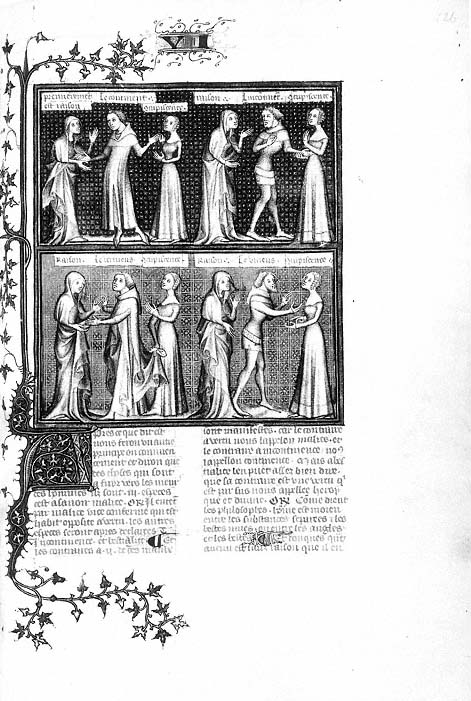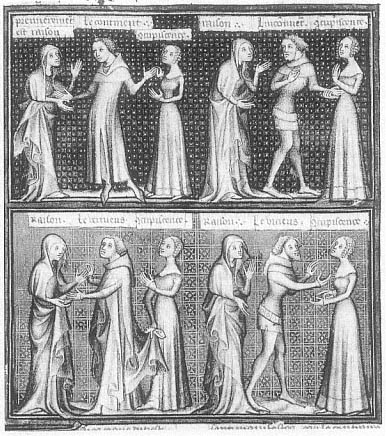Le Continent and L'Incontinent in A
Because of the complex meanings of the terms, Oresme defines both continent and incontinent in his glossary of difficult words. The translator takes great pains to emphasize the Aristotelian meaning of the words and to distinguish them from contemporary Christian usage:
CONTINENT. Celui est continent qui a mauvaises affeccions et temptacions par concupiscence a gloutonnie ou a luxure. Et avecques ce, il a bon jugement de raison, lequel il ensuit, et par ce il refraint ses mauvais desirriers. Et ce fu dit ou .xxi.e chapitre du premier en glose et appert plus a plain ou procés du .vii.e livre. Et si comme il fu dit en l'onzieme chapitre du .ix.e , il est dit continent pour ce que il se tient avecques raison et entendement. Car par ce il se tient avecques soy meïsmes; car chascun est principalment son ame intellective ou son entendement, si comme il fu dit ou quint et en le .xi.e chapitre du .ix.e et ou .xiiii.e chapitre du .x.e .
(CONTINENT. The continent man is one who through concupiscence is subject to bad desires for and temptations to gluttony or lechery. And at the same time he has good rational judgment, which he follows and by which he restrains his bad desires. And this was stated in the twenty-first chapter of the first book in a gloss and
is more fully discussed in the course of the seventh book. And as it was stated in the eleventh chapter of the ninth book, he is called continent because he conducts himself with reason and understanding. For by these means he restrains himself, for the intellective soul or understanding is the basic element of each of us, as was stated in the fifth and eleventh chapters of the ninth book and in the fourteenth chapter of the fifth book.)[4]
Oresme remains faithful to the text in including gluttony with sexual passions as temptations that the continent person can avoid by using good judgment founded on reason. In contrast, the incontinent man, subject to the same desires as his opposite number and holding "vrais principes morals" (true moral principles) and "bon jugement et raison" (good judgment and reason), is unable to resist these temptations. Instead, L'Incontinent is "vaincu et seürmonté par concupiscence, et delaisse raison et ensuit ses desiriers" (vanquished and overcome by concupiscence and abandons reason and follows his desires).[5]
Oresme's efforts to make clear the Aristotelian meanings of Continence and Incontinence in the glossary continue in other locations within the text and glosses. The summary title for Book VII introduces the words and offers a brief explanation of them: "Et aprés commence le .vii.e qui determine de continence, laquelle est une disposicion a vertu; et de incontinence, sa contraire; et de delectacion" (And here begins the seventh book, which examines Continence, which is a disposition toward virtue; and Incontinence, its opposite, and of pleasure).[6] The titles repeat the terms in thirteen of the twenty chapters that follow. Moreover, Oresme's commentary explaining not only the difference between the continent and incontinent persons but also two other states of virtues and vices appears on the same folio as the illustration. Thus, Oresme incorporates a variety of verbal definitions of Continence and Incontinence to which the reader can refer. The inscriptions provide clues for the translator's selection of the main concepts. The term Le Continent identifies the central figure in the left half of the illustration; L'Incontinent occupies the same position on the right. Once again, the inscriptions combine lexical and indexical functions.
Figure 35 is embedded in the first text column following the chapter headings and is placed above the introductory paragraph signaled by the six-line dentellated and foliated initial A . Although the position and dimensions of Figure 35 do not indicate importance within the cycle, the illustration has a unique feature. The miniature is divided into two vertical halves based on the contrast of the opposing characters of Le Continent and L'Incontinent. Previously, lateral division of the picture space in the illustrations of Books III, IV, and VI (Figs. 15, 20, and 33) correspond to identification and explanation of two separate subjects. This new ordering of the picture space by Oresme thus corresponds to the verbal definitions and contrasts he established in the glossary and commentary. Furthermore, the opposition between Continence and Incontinence is immediately set up in the first two paragraphs of the text, directly below and next to the miniature. As noted above, in his commentary Oresme further explains the essential distinctions
between Continence and Incontinence. There the reader also finds the relationships of these states to virtues and vices of different degrees. Even the contrasts of colors in the backgrounds and costumes of the figures carry out the theme of opposition and internal conflict set forth so emphatically in the text and commentary. To bring out these differences, the memory gateway places the opposing characters in separate but adjoining spaces divided by the central column.
The compositions, costumes, and gestures further clarify the contrasting choices made by Le Continent and L'Incontinent. Another way of putting the reader in the picture is Oresme's transformation of the adjectives Continent and Incontinent into nouns.[7] Le Continent and L'Incontinent become masculine equivalents, or concrete exemplars, of types of behavior analyzed by Aristotle. These physical doubles and opposites are identified by inscriptions unfurling vertically over their heads. Their short, tightly fitting jackets, low-slung belts, pointed shoes (poulains ), and colored hoods with trailing ends (liripipes ) distinguish them as fashionable, secular types. Both occupy the center of the shallow picture stage that avoids a strict axial or symmetrical organization. Instead, a more fluid composition pairs Le Continent with the figure on the left. The inscription identifies this personification: "Raison est ce" (this is Reason). Her widowlike headdress and ample blue robe resemble those of virtues like Actrempance and Liberalité (Figs. 15 and 20). Raison also occupies the same position in the right half of the miniature. The third figure, common to both scenes, stands on the right. Her inscription identifies her as Concupiscence (Sexual Desire). Her worldly status as a young woman of fashion is established by her braided tresses and fur-trimmed low-cut gown. In both scenes she proffers a chaplet of flowers, emblem of sensual pleasures.
The decision taken by Le Continent and L'Incontinent toward or away from the two types of conduct is expressed by the movement of their figures. Le Continent has literally turned his back on Concupiscence. His proximity to Raison, reinforced by his glance, the touch of his arm, and the position of his right foot emphasizes that he listens to her counsel. Yet, Le Continent indicates a struggle with his passions by pointing toward the eager and expectant figure of Concupiscence. A sense of uncertainty or anxiety about the outcome derives also from the expression of Raison's face and the tense gestures of her upraised and rigid hands. But the void between Le Continent and Concupiscence confirms the nature of his decision. The opposite conclusion takes place in the right half of the miniature, where L'Incontinent turns his back on Raison and moves in the direction of Concupiscence. Not only do his feet advance toward her, but he touches her shoulder with his outstretched left arm and with his other reaches for the wreath of flowers. Raison's resigned expression and upraised hand acknowledge that L'Incontinent has taken a step in the wrong direction. The vivid body language, expressed in visual metaphors such as "turning his back" or "taking a step in the right direction," reinforces the verbal language of the inscriptions.
The decision allegory in A is marked by a concrete and specific action taken by a contemporary secular figure. The visual evidence of moral struggle based on the protagonist's conflict between Reason and Desire is effectively conveyed. Whereas Aristotle did not single out sexual pleasure as the only area of moral

Figure 36
Above, from left : Raison, Le Continent, Concupiscence; Raison, L'Incontinent,
Concupiscence; below, from left : Raison, Le Vertueus, Concupiscence; Raison,
Le Vicieus, Concupiscence. Les éthiques d'Aristote, MS C.

Figure 36A
Detail of Fig. 36
conflict, Oresme may have chosen to do so because of the traditional medieval associations of the term Continence . Nevertheless, thanks to the fluent style of the Jean de Sy Master, the illustration makes clear the essence of the verbal definition. Oresme's instructions probably specified details of costume, gesture, and identity of the opposing protagonists. Such a program is an ingenious solution to the visual and verbal translations of subtle philosophical concepts clearly conveyed to Oresme's secular audience. Rooted in rhetorical strategies, complex visual devices such as repetition, opposition, and single versus double identities are designed to engage and enhance the cognitive and mnemonic responses of these readers.